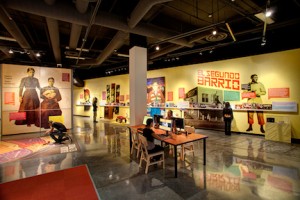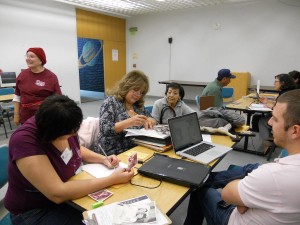Thoughts on completing my first major public history project
29 June 2012 – Vanessa Macias
employment, training, new professionals, projects, methods, public engagement, community history, memory, sense of place, education, profession

The gallery’s images (all from participant photos), color scheme, and typography were selected so that the space reflected the specific characteristics of the featured neighborhoods. The mural (to the right of the column) and wood paneling on the theater help to balance the shiny digital graphics. This view of the gallery shows one of the featured neighborhoods, the research computer table, oral history theater, and floor map activity. Courtesy of El Paso Museum of History and J. Ramirez Photography.
In 2004, I completed my MA graduate program in History with a sure sense of what was going to happen next: teach for a year, and then start a Ph.D. program. By 2007, I wasn’t sure if a Ph.D. was in my future and started exploring other options. I contacted the director of the El Paso Museum of History with a simple question: are there any internship opportunities at the museum? That question led to volunteering for a couple of museum events and then, after the museum received an IMLS Museums for America grant in 2008, they contracted me to be the project manager for an exhibit about El Paso’s neighborhoods. For five years, I oversaw the project’s development from concept to fabricated exhibit. It was an invaluable experience that confirmed just how satisfying and frustrating it can be to work in public history.
By 2008, I had started a second Master’s program in Public History. In the planning stages of the exhibit, the staff discussed many of the same types of questions we tangled with as grad students. For example, how does placing people’s voices into a museum gallery change the museum and change their stories? Or even more specifically, how do you explain a community-orientated, museum-based project to people who often don’t even know there is a history museum in El Paso? All of these questions demanded solutions that were creative, practical, flexible, and could be initiated quickly. Much as we tried, we didn’t always get at the root of the issue as deadlines and more pressing problems loomed over us. There just wasn’t the chance to stop and reflect, and I often missed that part of being a graduate student.
The graduate courses I took informed how I approached engaging the community and developing exhibit content. Yet I had to figure out a lot on my own, from learning how to maneuver through city government bureaucracy to managing office dynamics.
At the museum, I worked with a small staff that went through a couple of directors during the five-year period. I was the sole staffer who focused only on the neighborhoods project; the rest of the staff juggled several major responsibilities. As a result, they responded to my requests for assistance as quickly as their other projects allowed…which often wasn’t very quickly at all. Sometimes these delays resulted in missed deadlines or me moving forward without everybody’s input. Inexperience with this type of office workplace, plus the fact that I was a contract employee and new to the museum world, played a role in my reluctance to ask firmly for this issue to be addressed. At the same time, I knew the reality of packed schedules and over commitments and I realized the project was going to take a backseat more often than not. I felt the best option was to recover from any setbacks, work more hours if necessary, and move on.

We never knew what people would share with us at the Collection Day events. At this event in May 2010, the participant (center) and her mother (right) were from a particular section of El Segundo Barrio neighborhood called Rio Linda. This area had not come up in our research because those blocks were torn down for a highway. Making these types of discoveries was one of the best parts of working on the Neighborhoods project. Courtesy of Vanessa Macias.
The most satisfying part of the neighborhoods project was meeting with past and present residents of El Paso’s oldest neighborhoods. We held Collection Day events where residents brought their photographs and special mementos to share with staff and volunteers. I also visited a large number of participants in their homes to talk about the project and look at their photographs. Residents may not have understood how the exhibit would look, but they shared their experience with these neighborhoods enthusiastically. Through the difficult moments of the collections process, finalizing the exhibit design and fabrication, I reminded myself to bring the focus back to the participants and the exhibit’s purpose of presenting neighborhood history from a multi-generational perspective. It didn’t always ease the frustration, but it made the whole endeavor feel more like Public-History-in-action and less like drudgery.
The exhibit opening on March 8, 2012 was an amazing event with over 400 people attending. Participants oohed and aahed and sometimes cried as they walked through the gallery with their families and saw their pictures and special mementos. Since the opening, over 8,000 people (including primary and secondary school groups) have walked through the Neighborhoods exhibit. The staff reports positive feedback from visitors who often have a story to share about their connections to the featured neighborhoods. Several people have even contacted the curator to contribute photographs that depict their families in the featured neighborhoods. It is very satisfying to hear about this type of interaction because it means that Neighborhoods is a relevant and engaging exhibit.
Although the opening marked the end of my role as project manager, I’m not finished with the exhibit just yet. As part of a college-wide initiative to connect students to the local community, I designed a research project using the Neighborhoods exhibit for my U.S. History survey courses where students visit the gallery and select an exhibit theme to research further. This project provided insight into the exhibit’s strengths and weaknesses from another perspective. In the coming semesters, I plan to revise the project to experiment with how a museum exhibit can enhance survey courses.
Overall, I feel lucky that Neighborhoods was my first public history project because it offered a little bit of everything, from public outreach to working with a museum staff to exhibit design and fabrication. At times, the challenges felt insurmountable and the exhibit goals too Pollyannaish to ever achieve, but those feelings are part of working in Public History, too. Like all good first projects, the process didn’t scare me away; I’m ready to take what I learned and embark on the next big project.
~ Vanessa Macias teaches U.S. History at El Paso Community College. She holds an M.A. in History (American West) from the University of New Mexico and an M.A. in Public History from New Mexico State University. She is currently working on an article exploring how public spaces in El Paso reflect the community’s history.
Visit the Neighborhoods & Shared Memories Exhibit’s website.




1 comment